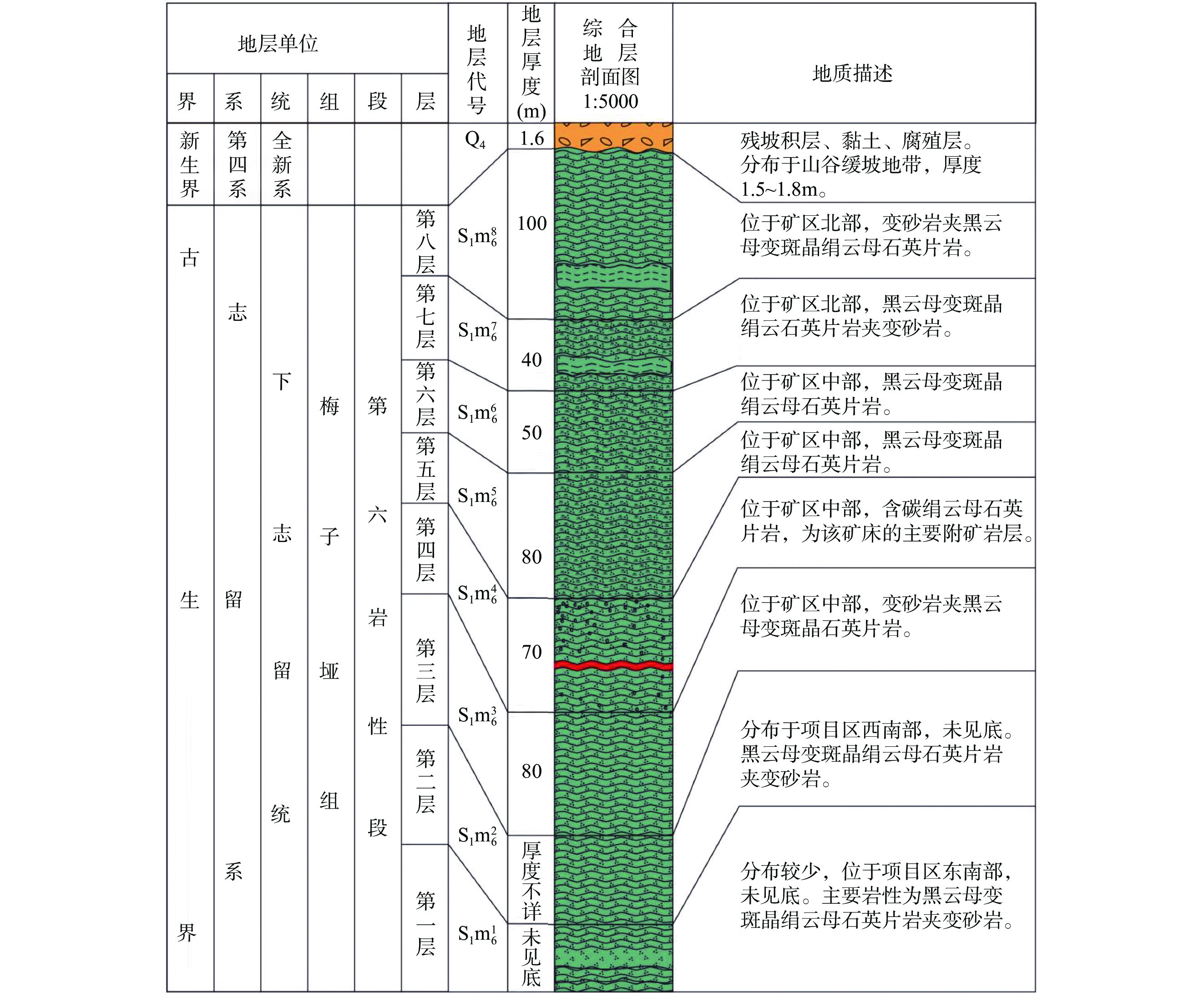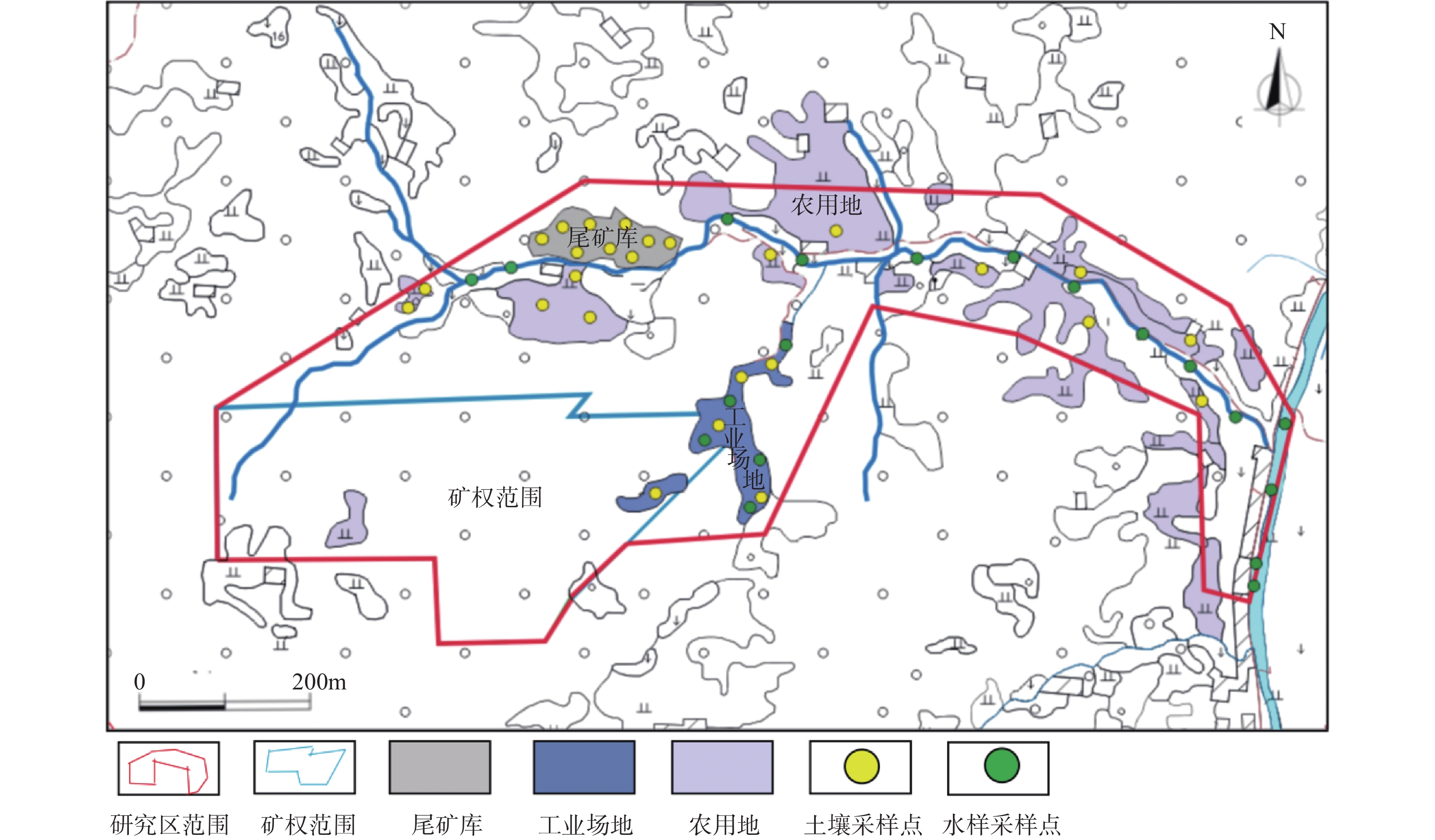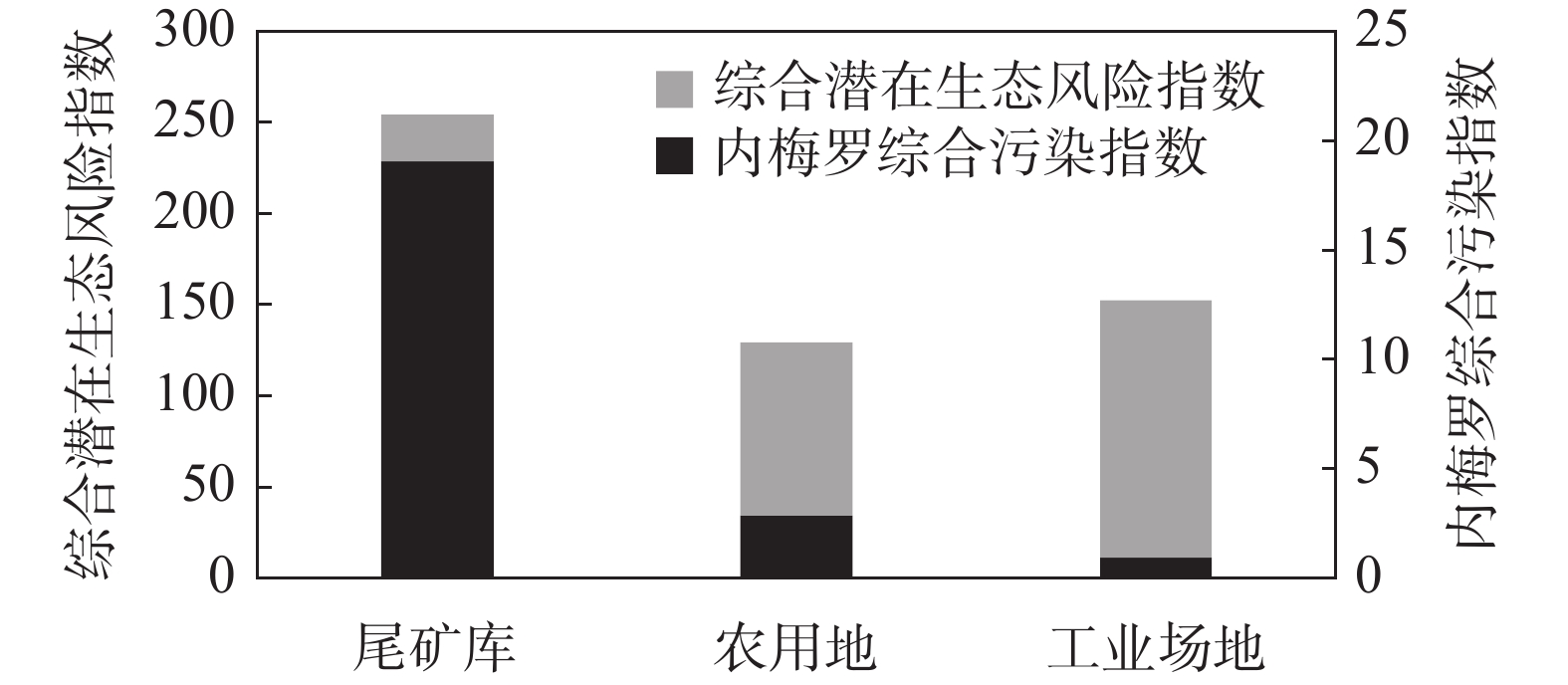Evaluation and Migration Path Analysis of Soil Heavy Metal Pollution in a Metal Mining Area of Qinling Mountain
-
摘要:
秦岭山区金属矿产资源丰富,但长期高强度、大规模的矿山开采遗留下来的矿山生态环境损害问题已经严重影响了秦巴地区的区域生态系统。为掌握秦岭山区金属矿山土壤中重金属污染物分布特征、生态风险以及迁移路径,本文以秦岭山区某金矿为研究对象,共采集69件样品(其中土壤样品50件、地表水样品19件),对Cd、Hg、As、Pb、Cr、Cu、Ni、Zn等8种重金属含量与pH进行分析。采用电感耦合等离子体质谱/发射光谱法(ICP-MS/OES)、原子荧光光谱法(AFS)等方法测定元素含量,研究矿区土壤中重金属污染程度与空间分布特征,并对矿区重金属的迁移路径进行了解析,采用单因子指数法、内梅罗综合指数法和潜在生态风险指数法对研究区土壤重金属污染程度和潜在生态风险进行评价。结果表明:①研究区内As、Cd、Hg、Cu、Ni变异系数较大,人为影响因素显著,As与Cd的污染最为严重,每个区域的检出结果均超出背景值。②从空间含量分布来看,尾矿库受重金属污染最为严重,其中As、Cd、Cr、Cu、Pb最高分别可超背景值28.9、22.6、1.41、8.69、0.345倍,农用地与工业场地次之,这与单项指数法、内梅罗综合污染指数法和潜在生态风险指数法的分析结果基本一致。③通过污染路径解析可知,采矿工程是引起研究区周边生态环境损害的重要原因,其中尾矿库渗水、硐口涌水是尤为显著的地表水污染源,而被污染的地表水又是引起农用地土壤污染的重要原因。
 Abstract:BACKGROUND
Abstract:BACKGROUNDThe Qinling Mountains are rich in metal mineral resources, but the problem of mine ecological environment damage left over from long-term high-intensity and large-scale mining has seriously affected the regional ecosystem in the Qinba area. Therefore, it is essential to objectively assess the characteristics and ecological risks of heavy metal pollution in the soil of the mining area, and to find out the migration path of heavy metals. In recent years, domestic and foreign scholars have carried out a lot of research work from the aspects of pollutant distribution characteristics[7-8], risk assessment[9-12], source analysis[13], etc. The distribution characteristics, risk assessment and migration path analysis of heavy metal pollutants in metal mine soil in the Qinling Mountain area need to be supplemented.
OBJECTIVESTo understand the pollution characteristics, migration path and pollution degree of soil heavy metal in metal mines of the Qinling Mountains.
METHODSA total of 50 soil samples and 19 surface water samples were collected in the study area. AFS, ICP-MS/OES were used to determine the contents of 8 heavy metals (Cd, Hg, As, Pb, Cr, Cu, Ni, Zn). The pollution degree and spatial distribution characteristics of heavy metals in the soil of the mining area were studied, and the migration path of heavy metals in the mining area was analyzed. The level of contamination and ecological risks was analyzed using the individual pollution index, Nemerow comprehensive pollution index and the potential ecological risk index.
RESULTSThe variation coefficient of As, Cd, Hg, Cu and Ni in the study area was large, and indicated that human intervention was more significant than initially thought. The pollution of As and Cd was the most serious; all the detection results exceeded the background value. The single Nemerow pollution index of Cd, Hg, As and Cu in the soil of the tailings pond area were all severe pollution grade, which were 18.60, 3.91, 24.62 and 6.96 times, respectively. The pollution level of Cd and As in agricultural land reached the severe pollution level, 5.36 and 4.99 times respectively. No detection index of industrial site reached the severe pollution level.
From the perspective of spatial content distribution, the tailings pond was the most seriously polluted by heavy metals, among which As, Cd, Cr, Cu and Pb exceeded the background value by 28.9, 22.6, 1.41, 8.69 and 0.345 times, respectively. Agricultural land and the industrial site followed, which was consistent with the analysis results of the single index method, Nemerow comprehensive pollution index method and potential ecological risk index method. Weighting the data by Nemerow composite pollution index of the 8 heavy metals, the tailings pond was 19.11, reaching the level of severe pollution; agricultural land was 2.86, which was moderately polluted; the industrial site was 0.96, which was the warning value. The analysis results of potential ecological risk assessment index of heavy metals showed that the comprehensive risk index of tailings pond was 255.9, presenting a medium risk grade. Agricultural land was 130.23, which was low ecological risk grade. The industrial site was 152.66, which was medium risk.
CONCLUSIONSAccording to the analysis of pollution path, it can be seen that mining engineering is an important cause of ecological environmental damage around the study area, among which water seepage and water gushing at the tailings pond are particularly significant pollution sources, and polluted surface water is an important cause of soil pollution on agricultural land. It is suggested that heavy metal pollution in the tailings pond should be the focus for later restoration and treatment process of soil ecological environment in mining areas, and heavy metal indicators such as As, Cd, Hg and Cr should be continuously monitored.
-
Keywords:
- metal mining area /
- soil /
- heavy metals /
- pollution characteristics /
- risk assessment /
- migration path

-
-
表 1 单项潜在生态风险指数($ {E}_{\mathrm{i}} $)及综合潜在生态风险指数(RI)与生态风险水平
Table 1 Single potential ecological risk index ($ {E}_{\mathrm{i}} $), comprehensive potential ecological risk index ($ RI $) and risk level.
单项潜在生态风险指数 综合潜在生态风险指数 $ {E}_{{\mathrm{i}}} $ 生态风险水平 $ RI $ 生态风险水平 <40 低生态风险 <150 低生态风险 40~80 中等生态风险 150~300 中等生态风险 80~160 较高生态风险 300~600 高生态风险 160~320 高生态风险 ≥600 极高生态风险 ≥320 极高生态风险 表 2 矿区土壤重金属含量统计特征分析
Table 2 Analysis of heavy metal concentrations in the soil of study area.
测试项目 采样区域 含量最大值
(mg/kg)含量最小值
(mg/kg)含量算术平均值
(mg/kg)标准差
(mg/kg)变异系数 含量基线值
(mg/kg)pH 尾矿库 6.97 2.93 3.95 0.82 0.21 6.15 农用地 6.56 4.33 5.72 0.74 0.13 工业场地 4.35 2.79 3.85 0.51 0.13 Cd 尾矿库 8.92 0.03 0.68 2.07 3.07 0.34 农用地 2.51 0.26 0.59 0.56 0.94 工业场地 0.33 0.022 0.08 0.11 1.51 Hg 尾矿库 0.27 0.002 0.02 0.06 3.32 0.06 农用地 0.2 0.03 0.07 0.05 0.71 工业场地 0.005 0.003 0.004 0.001 0.22 As 尾矿库 242 85.9 130.0 48.40 0.37 7.89 农用地 54.4 4.25 12.13 11.69 0.96 工业场地 157 63.9 105.2 32.14 0.31 Pb 尾矿库 30.5 22.7 26.1 2.05 0.08 22.96 农用地 43.6 18.4 23.9 5.57 0.23 工业场地 21.4 18.4 20.7 1.05 0.05 Cr 尾矿库 203 70.5 111.2 35.53 0.32 85.74 农用地 98.3 64.5 83.9 8.72 0.10 工业场地 102 73.1 81.6 10.43 0.13 Cu 尾矿库 373 10.1 53.7 85.30 1.59 38.29 农用地 85.6 29.4 45.3 13.87 0.31 工业场地 70 12.4 22.1 21.15 0.96 Ni 尾矿库 160 2.96 26.56 39.96 1.50 45.58 农用地 83.7 29.9 46.5 11.75 0.25 工业场地 29.6 3.53 7.79 9.63 1.24 Zn 尾矿库 355 55 112.6 66.49 0.59 122.75 农用地 219 79.5 120 31.96 0.27 工业场地 71 55.7 62.8 6.06 0.10 注:pH值无量纲。 表 3 研究区不同重金属在不同采样区域中的单因子污染指数
Table 3 Single factor pollution index of different heavy metals in different sampling areas in the study area.
测试项目 采样区域 单因子污染指数 污染程度样本统计 超标率
(%)最大值 最小值 算术平均值 无污染 轻度 中度 重度 Cd 尾矿库 26.24 0.07 1.99 13 3 1 1 27.78 农用地 7.38 0.76 1.74 3 10 1 2 81.25 工业场地 0.97 0.06 0.22 7 0 0 0 0 Hg 尾矿库 4.50 0.03 0.31 17 0 0 1 5.56 农用地 3.33 0.45 1.09 10 4 1 1 37.50 工业场地 0.005 0.003 0.004 7 0 0 0 0 As 尾矿库 30.67 10.89 16.47 0 0 0 18 100.00 农用地 6.89 0.54 1.54 4 10 1 1 75.00 工业场地 19.90 8.10 13.33 0 0 0 7 100.00 Pb 尾矿库 1.33 0.99 1.14 0 18 0 0 100.00 农用地 1.90 0.80 1.04 7 9 0 0 56.25 工业场地 0.93 0.80 0.90 7 0 0 0 0 Cr 尾矿库 2.37 0.82 1.30 5 12 1 0 72.22 农用地 1.15 0.75 0.98 8 8 0 0 50.00 工业场地 1.19 0.85 0.95 5 2 0 0 28.57 Cu 尾矿库 9.74 0.26 1.40 13 0 4 1 27.78 农用地 2.24 0.77 1.18 5 10 1 0 68.75 工业场地 1.83 0.32 0.58 6 1 0 0 14.29 Ni 尾矿库 3.51 0.06 0.58 15 2 0 1 16.67 农用地 1.84 0.66 1.02 8 8 0 0 50.00 工业场地 0.65 0.08 0.17 7 0 0 0 0 Zn 尾矿库 2.89 0.45 0.92 13 4 1 0 27.78 农用地 1.78 0.65 0.97 10 6 0 0 37.50 工业场地 0.58 0.45 0.51 7 0 0 0 0 表 4 土壤重金属内梅罗综合污染评价结果
Table 4 Results of Nemerow comprehensive pollution index of heavy metals in soil.
采样区域 单项内梅罗综合污染指数 内梅罗综合
污染指数Cd Hg As Pb Cr Cu Ni Zn 尾矿库 18.60 3.19 24.62 1.24 1.91 6.96 2.52 2.15 19.11
(重度污染)污染水平 重度污染 重度污染 重度污染 轻度污染 轻度污染 重度污染 中度污染 中度污染 污染权重(%) 8.26 1.29 68.34 4.73 5.39 5.81 2.41 3.82 农用地 5.36 2.48 4.99 1.53 1.07 1.79 1.49 1.44 2.86
(中度污染)污染水平 重度污染 中度污染 重度污染 轻度污染 轻度污染 轻度污染 轻度污染 轻度污染 污染权重(%) 18.20 11.40 16.11 10.88 10.25 12.34 10.67 10.15 工业场地 0.70 0.07 16.94 0.92 1.08 1.36 0.47 0.55 0.96
(污染警戒值)污染水平 安全 安全 重度污染 警戒值 轻度污染 轻度污染 安全 安全 污染权重(%) 79.53 0.60 1.31 5.37 5.67 3.46 1.01 3.04 表 5 土壤重金属潜在生态风险评价结果
Table 5 Results of potential ecological risk assessment of heavy metals in soil.
采样区域 单项潜在生态风险指数/单项风险程度 综合风险指数
(综合风险程度)Cd Hg As Pb Cr Cu Ni Zn 尾矿库 59.7
中等生态风险12.4
低生态风险164.7
高生态风险5.7
低生态风险2.6
低生态风险7.0
低生态风险2.9
低生态风险0.9
低生态风险255.9
中等生态风险农用地 52.2
中等生态风险43.6
中等生态风险15.4
低生态风险5.2
低生态风险1.96
低生态风险5.9
低生态风险5.1
低生态风险0.87
低生态风险130.23
低生态风险工业场地 6.6
低生态风险2.4
低生态风险133.0
较高生态风险4.5
低生态风险1.9
低生态风险2.9
低生态风险0.85
低生态风险0.51
低生态风险152.66
中等生态风险 -
[1] 孙建伟, 贾煦, 刘向东, 等. 豫西金矿集区矿业活动对周边农田土壤重金属影响研究[J]. 岩矿测试, 2023, 42(1): 192−202. doi: 10.3969/j.issn.0254-5357.2023.1.ykcs202301015 Sun J W, Jia X, Liu X D, et al. Influence of mining activities in the gold ore concentration area in Western Henan on the heavy metals in surrounding farmland soil[J]. Rock and Mineral Analysis, 2023, 42(1): 192−202. doi: 10.3969/j.issn.0254-5357.2023.1.ykcs202301015
[2] Gu Y G, Gao Y P. Bioaccessibilities and health implications of heavy metals in exposed-lawn soils from 28 urban parks in the megacity Guangzhou inferred from an in vitro physiologically based extraction test[J]. Ecotoxicology and Environmental Safety, 2017, 148(2): 747−753.
[3] Han Q, Wang M S, Cao J L, et al. Health risk assessment and bioaccessibilities of heavy metals for children in soil and dust from urban parks and schools of Jiaozuo, China[J]. Ecotoxicology and Environmental Safety, 2020, 191: 110157. doi: 10.1016/j.ecoenv.2019.110157
[4] 王锐, 邓海, 严明书, 等. 重庆市酉阳县南部农田土壤重金属污染评估及来源解析[J]. 环境科学, 2020, 41(10): 4749−4756. doi: 10.13227/j.hjkx.202003175 Wang R, Deng H, Yan M S, et al. Assessment and source analysis of heavy metal pollution in farmland soil in the south of Youyang County, Chongqing[J]. Environmental Science, 2020, 41(10): 4749−4756. doi: 10.13227/j.hjkx.202003175
[5] 张金莲, 丁疆峰, 卢桂丁, 等. 广东清远电子垃圾拆解区农田土壤重金属污染评价[J]. 环境科学, 2015, 36(7): 2633−2640. doi: 10.13227/j.hjkx.2015.07.041 Zhang J L, Ding J F, Lu G D, et al. Heavy metal contamination in farmland soils at an E-waste disassembling site in Qingyuan, Guangdong, South China[J]. Environmental Science, 2015, 36(7): 2633−2640. doi: 10.13227/j.hjkx.2015.07.041
[6] Guo G H, Wu F C, Xie F Z, et al. Spatial distribution and pollution assessment of heavy metals in urban soils from Southwest China[J]. Journal of Environment Sciences, 2012, 24(3): 410−418. doi: 10.1016/S1001-0742(11)60762-6
[7] 王硕, 王湛, 魏文侠, 等. 某钢铁厂土壤重金属砷空间分布特征分析[J]. 环境保护科学, 2019, 45(3): 110−114. doi: 10.16803/j.cnki.issn.1004-6216.2019.03.020 Wang S, Wang Z, Wei W X, et al. Analysis of spatial distribution characteristics of arsenic in soil of a steel plant[J]. Environmental Protection Science, 2019, 45(3): 110−114. doi: 10.16803/j.cnki.issn.1004-6216.2019.03.020
[8] 吴劲楠, 龙健, 刘灵飞, 等. 某铅锌矿区农田重金属分布特征及其风险评价[J]. 中国环境科学, 2018, 38(3): 1054−1063. doi: 10.3969/j.issn.1000-6923.2018.03.032 Wu J N, Long J, Liu L F, et al. Spatial distribution and risk assessment of heavy metal pollution in farmland soil of a lead-zinc mining area[J]. China Environmental Science, 2018, 38(3): 1054−1063. doi: 10.3969/j.issn.1000-6923.2018.03.032
[9] 李志涛, 王夏晖, 何俊, 等. 四川省江安县某硫铁矿区周边农田土壤重金属来源解析及污染评价[J]. 农业环境科学学报, 2019, 38(6): 1272−1279. doi: 10.11654/jaes.2018-1076 Li Z T, Wang X H, He J, et al. Source identification and pollution assessment of heavy metals in farmland soils around a pyrite mining area in Jiang’an County, Sichuan Province, China[J]. Journal of Agro-Environment Science, 2019, 38(6): 1272−1279. doi: 10.11654/jaes.2018-1076
[10] 周艳, 陈樯, 邓绍坡, 等. 西南某铅锌矿区农田土壤重金属空间主成分分析及生态风险评价[J]. 环境科学, 2018, 39(6): 2884−2892. doi: 10.13227/j.hjkx.201707125 Zhou Y, Chen Q, Deng S P, et al. Principal component analysis and ecological risk assessment of heavy metals in farmland soils around a Pb-Zn mine in Southwestern China[J]. Environmental Science, 2018, 39(6): 2884−2892. doi: 10.13227/j.hjkx.201707125
[11] Huang S H, Yuan C Y, Li Q, et al. Distribution and risk assessment of heavy metals in soils from a typical Pb-Zn mining area[J]. Polish Journal of Environmental Studies, 2017, 26(3): 1105−1112. doi: 10.15244/pjoes/68424
[12] 杨杰, 董静, 宋洲, 等. 鄂西铜铅锌尾矿库周边农田土壤-水稻重金属污染状况及风险评价[J]. 岩矿测试, 2022, 41(5): 867−879. Yang J, Dong J, Song Z, et al. Heavy metal pollution characteristics and risk assessment of soil and rice in farmland around the copper-lead-zinc tailing, Western Hubei Province[J]. Rock and Mineral Analysis, 2022, 41(5): 867−879.
[13] 杨安, 王艺涵, 胡健, 等. 青藏高原表土重金属污染评价与来源解析[J]. 环境科学, 2020, 41(2): 886−894. Yang A, Wang Y H, Hu J, et al. Evaluation and source of heavy metal pollution in surface soil of Qinghai—Tibet Plateau[J]. Environmental Science, 2020, 41(2): 886−894.
[14] 刘硕, 吴泉源, 曹学江, 等. 龙口煤矿区土壤重金属污染评价与空间分布特征[J]. 环境科学, 2016, 37(1): 270−279. doi: 10.13227/j.hjkx.2016.01.035 Liu S, Wu Q Y, Cao X J, et al. Pollution assessment and spatial distribution characteristics of heavy metals in soils of coal mining area in Longkou City[J]. Environmental Science, 2016, 37(1): 270−279. doi: 10.13227/j.hjkx.2016.01.035
[15] 刘洋, 何朝辉, 牛学奎, 等. 云南某矿区小流域土壤重金属健康风险评价[J]. 环境科学, 2022, 43(2): 936−945. doi: 10.13227/j.hjkx.202105114 Liu Y, He Z H, Niu X K, et al. Health risk assessment of soil heavy metals in a small watershed of a mining area in Yunnan[J]. Environmental Science, 2022, 43(2): 936−945. doi: 10.13227/j.hjkx.202105114
[16] 李荣华, 冯静, 李晓龙, 等. 陕西某关闭冶炼厂土壤重金属污染评价与工程修复[J]. 农业机械学报, 2015, 46(10): 223−228. doi: 10.6041/j.issn.1000-1298.2015.10.029 Li R H, Feng J, Li X L, et al. Heavy metals polluted soil environment assessment and engineering remediation practice in closed smelter in Shaanxi Province[J]. Transactions of the Chinese Society for Agricultural Machinery, 2015, 46(10): 223−228. doi: 10.6041/j.issn.1000-1298.2015.10.029
[17] 徐友宁, 张江华, 柯海玲, 等. 某金矿区农田土壤重金属污染的人体健康风险[J]. 地质通报, 2014, 33(8): 1239−1252. Xu Y N, Zhang J H, Ke H L, et al. Human health risk under the condition of farmland soil heavy metals pollution in a gold mining area[J]. Geological Bulletin of China, 2014, 33(8): 1239−1252.
[18] 方睿红. 秦巴山区土壤肥力特征及质量综合评价研究——以汉阴县为例[D]. 杨凌: 西北农林科技大学, 2012. Fang R H. Soil fertility characteristics and comprehensive evaluation in Qinling—Bashan mointainous area—A case study of Hanyin County[D]. Yangling: Northwest A&F University, 2012.
[19] 杨本昭, 吴邦朝, 王新社. 陕西省汉阴县铁佛—汉滨区流芳金矿地质特征及找矿标志[J]. 陕西地质, 2010, 28(1): 12−17. Yang B Z, Wu B Z, Wang X S, et al. Geological features and prospecting indicators of gold ore in Liufang area of Tiefo—Hanbin district in Hanyin County, Shannxi Province[J]. Geology of Shannxi, 2010, 28(1): 12−17.
[20] 张鹏岩, 秦明周, 陈龙, 等. 黄河下游滩区开封段土壤重金属分布特征及其潜在风险评价[J]. 环境科学, 2013, 34(9): 3654−3662. doi: 10.13227/j.hjkx.2013.09.048 Zhang P Y, Qin M Z, Chen L, et al. Study on distribution characteristics and potential ecological risk of soil heavy metals in the Yellow River Beach Region in Kaifeng City[J]. Environmental Science, 2013, 34(9): 3654−3662. doi: 10.13227/j.hjkx.2013.09.048
[21] 尹国庆, 江宏, 王强, 等. 安徽省典型区农用地土壤重金属污染成因及特征分析[J]. 农业环境科学学报, 2018, 37(1): 96−104. Yin G Q, Jiang H, Wang Q, et al. Analysis of the sources and characteristics of heavy metals in farmland soil from a typical district in Anhui Province[J]. Journal of Agro-Environment Science, 2018, 37(1): 96−104.
[22] 沈城, 刘馥雯, 吴健, 等. 再开发利用工业场地土壤重金属含量分布及生态风险[J]. 环境科学, 2020, 41(11): 5125−5132. doi: 10.13227/j.hjkx.202003267 Shen C, Liu F W, Wu J, et al. Distribution and ecological risk of heavy metals in the soil of redevelopment industrial sites[J]. Environmental Science, 2020, 41(11): 5125−5132. doi: 10.13227/j.hjkx.202003267
[23] 杨冰雪, 马勤, 方晨, 等. 杭州市临安区农田土壤重金属污染调查与评价[J]. 四川环境, 2020, 39(3): 132−138. doi: 10.14034/j.cnki.schj.2020.03.022 Yang B X, Ma Q, Fang C, et al. Investigation and evaluation of heavy metal pollution of farmland soil in Lin’an district of Hangzhou City[J]. Sichuan Environment, 2020, 39(3): 132−138. doi: 10.14034/j.cnki.schj.2020.03.022
[24] 陈泽华, 焦思, 余爱华, 等. 土壤重金属污染评价方法探析——以南京市为例[J]. 森林工程, 2020, 36(3): 28−36. doi: 10.16270/j.cnki.slgc.2020.03.005 Chen Z H, Jiao S, Yu A H, et al. Analysis on evaluation methods of heavy metal pollution in soil—Taking Nanjing as an example[J]. Forest Engineering, 2020, 36(3): 28−36. doi: 10.16270/j.cnki.slgc.2020.03.005
[25] 何博, 赵慧, 王铁宇, 等. 典型城市化区域土壤重金属污染的空间特征与风险评价[J]. 环境科学, 2019, 40(6): 2869−2876. doi: 10.13227/j.hjkx.201810057 He B, Zhao H, Wang T Y, et al. Spatial distribution and risk assessment of heavy metals in soils from a typical urbanized area[J]. Environmental Science, 2019, 40(6): 2869−2876. doi: 10.13227/j.hjkx.201810057
[26] 陈展, 吴育林, 张刚, 等. 上海市某大型再开发场地土壤重金属污染特征评价及来源分析[J]. 水土保持通报, 2021, 41(1): 227−236. Chen Z, Wu Y L, Zhang G, et al. Pollution characteristics, assessment, and source analysis of soil heavy metals in large-scale redevelopment site in Shanghai City[J]. Bulletin of Soil and Water Conservation, 2021, 41(1): 227−236.
[27] 李吉玫, 张毓涛. 乌鲁木齐不同功能区林带土壤重金属污染特征分析[J]. 生态环境学报, 2019, 28(9): 1859−1866. doi: 10.16258/j.cnki.1674-5906.2019.09.018 Li J M, Zhang Y T. Characteristics of heavy-metal pollution in forest belt soil of different functional zones in Urumqi, Xinjiang[J]. Ecology and Environmental Sciences, 2019, 28(9): 1859−1866. doi: 10.16258/j.cnki.1674-5906.2019.09.018
[28] Hakanson L. An ecological risk index for aquatic pollution control. A sedimentological approach[J]. Water Research, 1980, 14(8): 975−1001. doi: 10.1016/0043-1354(80)90143-8
[29] 孙荣基, 陈志莉, 盛利伟. 铅蓄电池厂遗留场地污染分析与风险评价[J]. 西南大学学报(自然科学版), 2017, 39(8): 146−152. doi: 10.13718/j.cnki.xdzk.2017.08.021 Sun R J, Chen Z L, Sheng L W. Pollution analysis and risk assessment of the remaining site of a relocated lead acid battery factory[J]. Journal of Southwest University (Natural Science Edition), 2017, 39(8): 146−152. doi: 10.13718/j.cnki.xdzk.2017.08.021
[30] 常文静, 李枝坚, 周妍姿, 等. 深圳市不同功能区土壤表层重金属污染及其综合生态风险评价[J]. 应用生态学报, 2020, 31(3): 999−1007. doi: 10.13287/j.1001-9332.202003.036 Chang W J, Li Z J, Zhou Y Z, et al. Heavy metal pollution and comprehensive ecological risk assessment of surface soil in different functional areas of Shenzhen, China[J]. Chinese Journal of Applied Ecology, 2020, 31(3): 999−1007. doi: 10.13287/j.1001-9332.202003.036
[31] 刘勇, 岳玲玲, 李晋昌. 太原市土壤重金属污染及其潜在生态风险评价[J]. 环境科学学报, 2011, 31(6): 1285−1293. doi: 10.13671/j.hjkxxb.2011.06.025 Liu Y, Yue L L, Li J C. Evaluation of heavy metal contamination and its potential ecological risk to the soil in Taiyuan, China[J]. Acta Scientiae Circumstantiae, 2011, 31(6): 1285−1293. doi: 10.13671/j.hjkxxb.2011.06.025
[32] Pan L B, Wang Y, Ma J, et al. A review of heavy metal pollution levels and health risk assessment of urban soils in Chinese cities[J]. Environmental Science and Pollution Research, 2018, 25(2): 1055−1069. doi: 10.1007/s11356-017-0513-1
[33] 石兰英, 田新民, 王永林, 等. 兴凯湖地区天然沼泽和森林土壤重金属分布特征及潜在生态风险[J]. 湖北农业科学, 2017, 56(22): 4299−4303. doi: 10.14088/j.cnki.issn0439-8114.2017.22.022 Shi L Y, Tian X M, Wang Y L, et al. Distribution characteristics and ecological risk assessment of heavy metals under natural marsh and forest soil in Xingkai Lake, China[J]. Hubei Agricultural Sciences, 2017, 56(22): 4299−4303. doi: 10.14088/j.cnki.issn0439-8114.2017.22.022
[34] 林海, 董颖博, 李冰, 等. 有色金属矿区水体和土壤重金属污染治理[M]. 北京: 科学出版社, 2020. Lin H, Dong Y B, Li B, et al. Treatment of heavy metal pollution in water and soil of nonferrous metal mining area[M]. Beijing: Science Press, 2020.
[35] 李金天, 束文圣, 杨胜香, 等. 有色金属矿山尾矿库生态修复[M]. 北京: 科学出版社, 2021. Li J T, Shu W S, Yang S X, et al. Ecological restoration of tailings pond in nonferrous metal mine[M]. Beijing: Science Press, 2021.
[36] 陆英, 肖满, 卜繁婷. 唐山某盐碱水稻田重金属污染调查与评价[J]. 环境科学与技术, 2021, 44(S2): 352−358. doi: 10.19672/j.cnki.1003-6504.2291.20.338 Lu Y, Xiao M, Bu F T. Investigation and evaluation of heavy metal pollution in a saline alkali rice field in Tangshan City[J]. Environmental Science & Technology, 2021, 44(S2): 352−358. doi: 10.19672/j.cnki.1003-6504.2291.20.338
-
其他相关附件




 下载:
下载:


 京公网安备 11010202008159号
京公网安备 11010202008159号